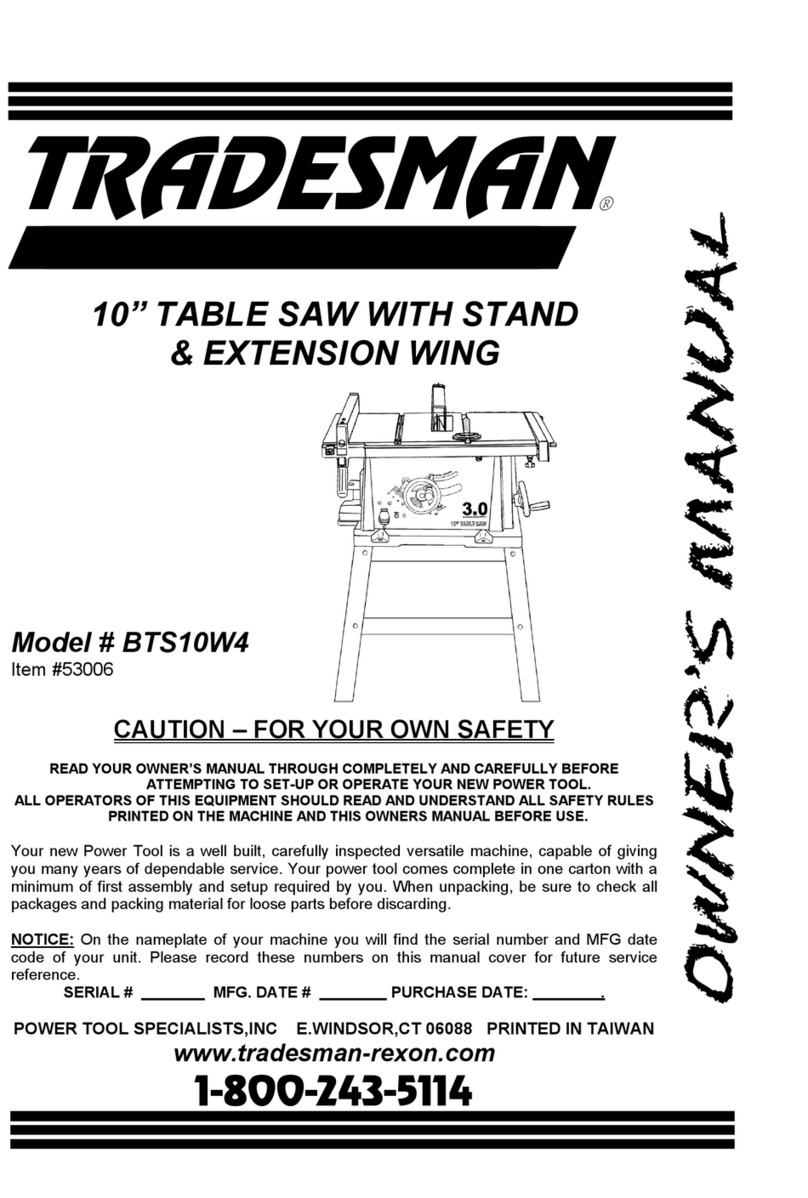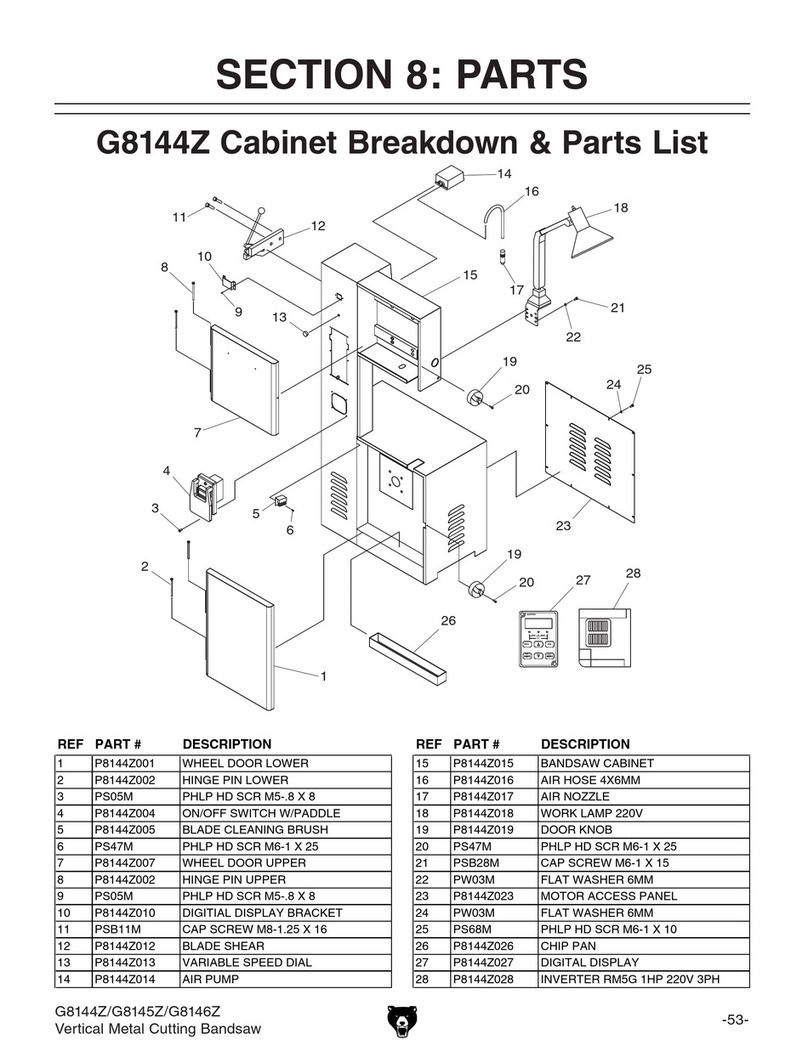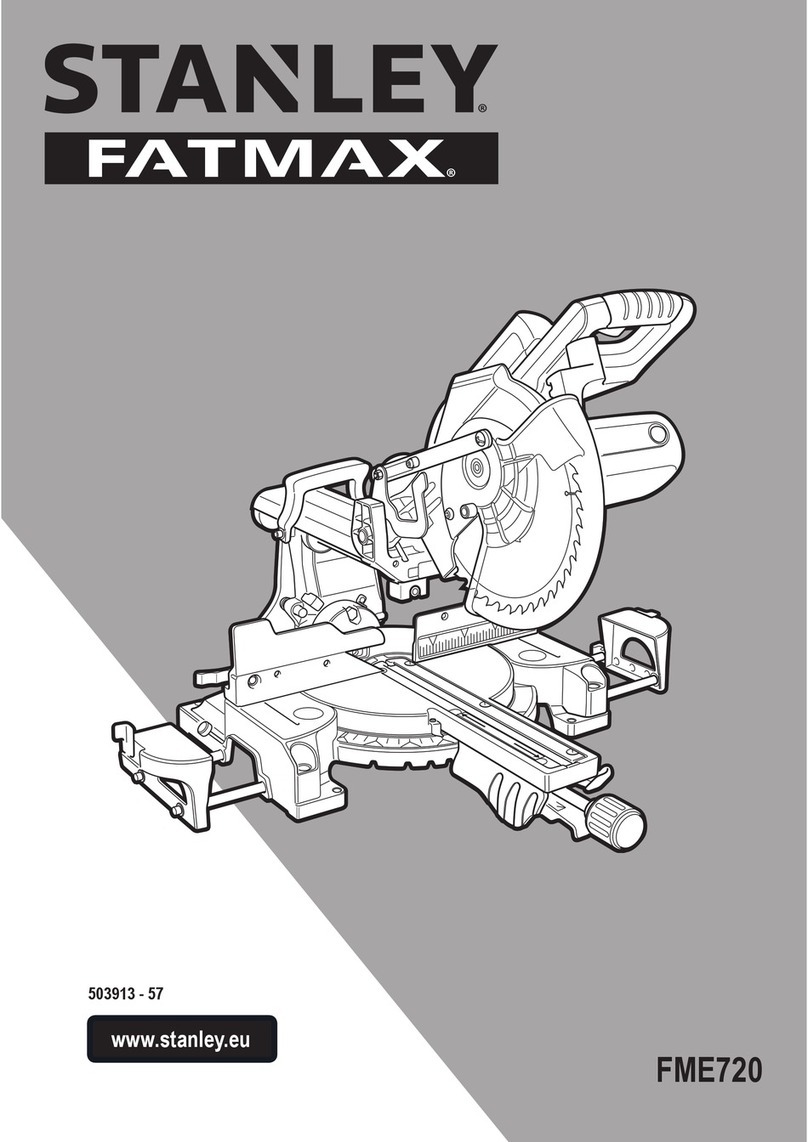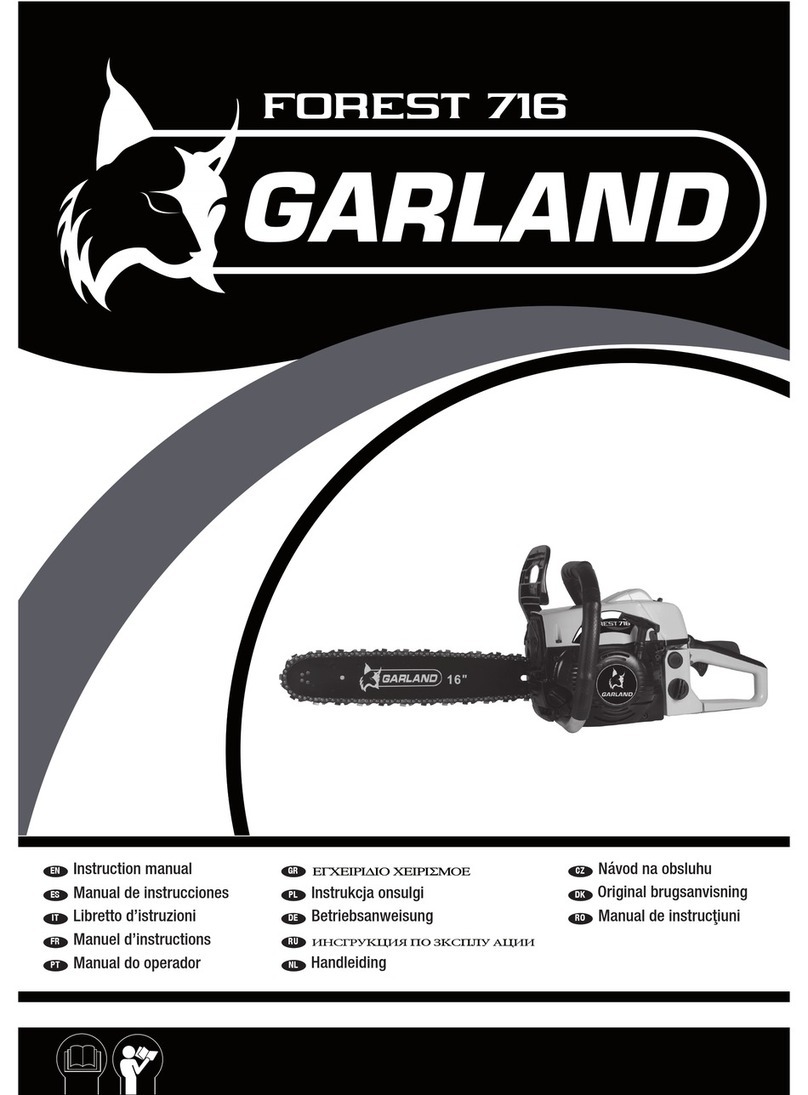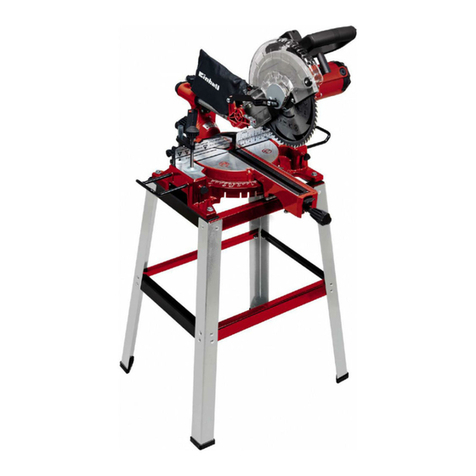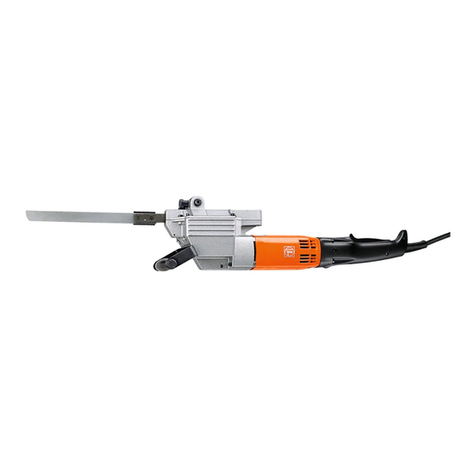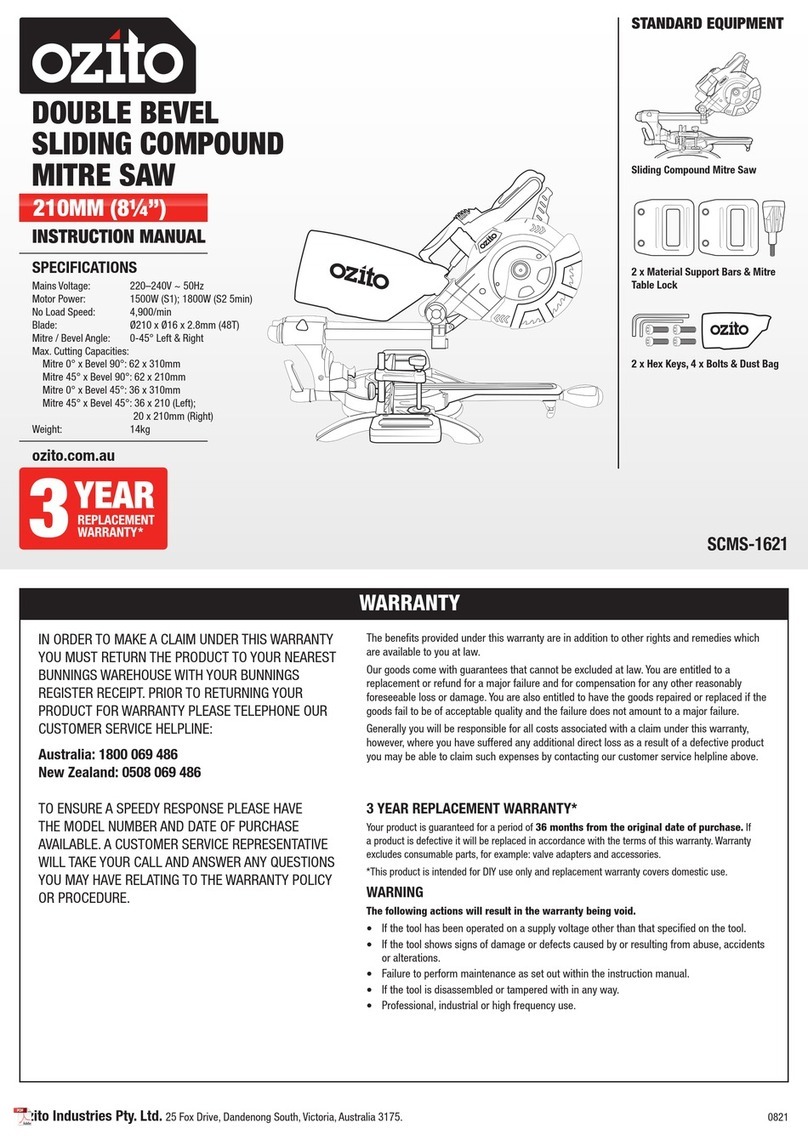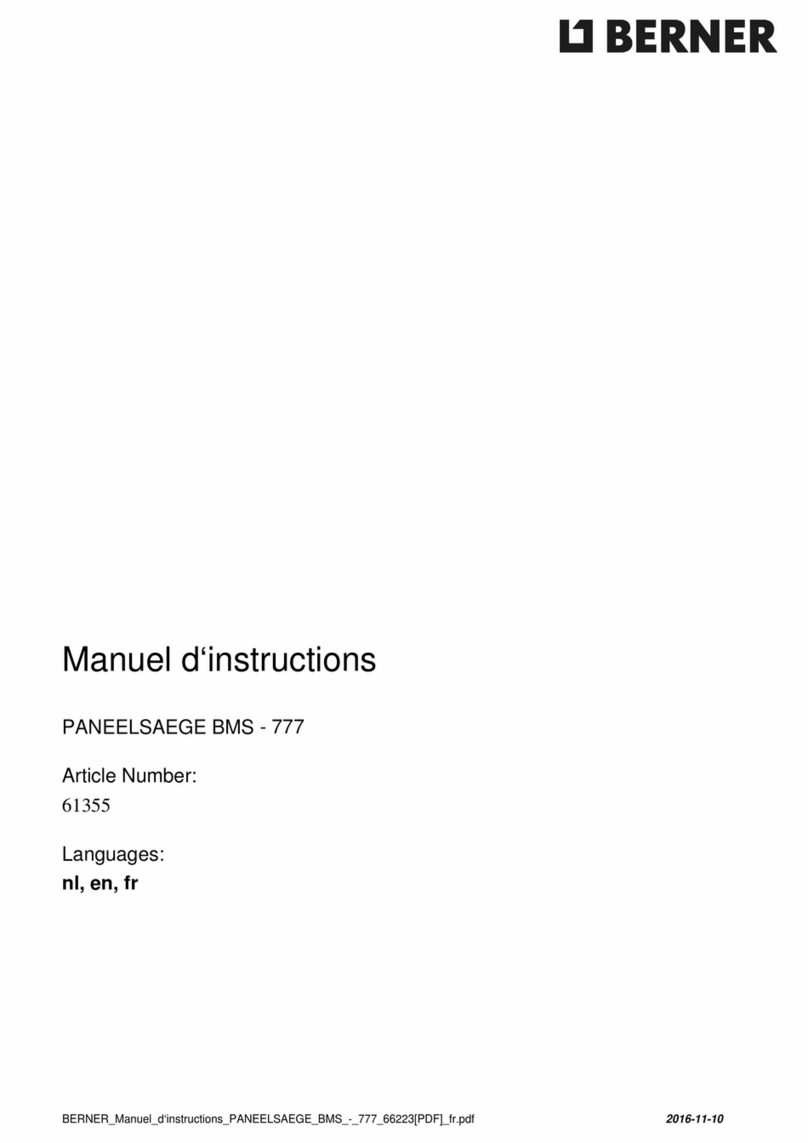Benchmark 1265-002 User manual

20V BRUSHLESS
WEAR CSA APPROVED
EYE PROTECTION
WEAR EAR
PROTECTION
WEAR A
FACE MASK
READ ALL INSTRUCTIONS BEFORE FIRST USE.
KEEP THIS MANUAL FOR FUTURE REFERENCE.
KEEP AWAY FROM CHILDREN.
Maximum initial battery voltage (measured without a load)
is 20 volts. Nominal voltage is 18 volts.
5
Battery and charger not included
Year Limited Warranty on tool
JD539220
E114847

1
PRODUCT SPECIFICATIONS
20V MAX BRUSHLESS 7-1/4" CIRCULAR SAW
Rating 20V
No Load Speed 4500 RPM
Blade 7-1/4" (185mm) 24Tooth Carbon Tipped
Arbor 5/8" (16mm)
Cut at 90° 2-9/16" (65mm)
Cut at 45° 2" (50mm)
Cut at 50° 1-3/4" (45mm)
Weight 6.4 lb. (2.9Kg) Tool Only
Batteries (Sold Separately) 5350-023 (2.5Ah), 5350-011 (4Ah),
5350-012 (5Ah)
Charger (Sold Separately) 5350-010 2.4Amp or 5350-022 6A
Fast Charger
NEED ASSISTANCE?
Call us on our toll-free customer support line:
1-866-349-8665 (Monday through Friday 9am – 5pm Eastern Standard Time)
• Technical questions
• Replacement parts
• Parts missing from package

2
20V BRUSHLESS 7-1/4" CIRCULAR SAW 1265-002
TABLE OF CONTENTS
Product Specifications................................................................................... 1
Table of Contents ........................................................................................... 2
General Safety Instructions ............................................................................ 3
Eye, Ear & Lung Protection............................................................................. 3
Electrical Safety............................................................................................. 3
Work area safety ............................................................................................ 4
Electrical Safety............................................................................................. 4
Personal safety .............................................................................................. 4
Power tool use and care ................................................................................. 5
Service .......................................................................................................... 6
Specific Safety Instructions for Brushless 7-1/4" Circular Saw ........................ 6
Causes & Operator Prevention of Kickback..................................................... 8
Safety Instructions Regarding Lower Guard .................................................... 9
Additional Warnings ....................................................................................... 9
Laser Light Safety Rules............................................................................... 10
Symbols....................................................................................................... 11
Know Your 20v Max Brushless 7-1/4" Circular Saw ....................................... 12
Assembly..................................................................................................... 13
Installing Blades .......................................................................................... 13
Removing the Blade..................................................................................... 14
Attaching the Edge Guide............................................................................. 14
Operating Instructions ................................................................................. 15
Guarding Against Kickback .......................................................................... 15
Adjustments ................................................................................................ 17
Depth of Cut At 90°...................................................................................... 17
Angle of Cut 0-45° ....................................................................................... 17
Starting and Stopping .................................................................................. 18
Operating the Laser Light ............................................................................. 18
Maintenance ............................................................................................... 18
General Maintenance................................................................................... 19
Lubrication .................................................................................................. 19
Environmental Protection............................................................................. 19
Exploded View ............................................................................................. 20
Parts List ..................................................................................................... 21
Warranty...................................................................................................... 22

3
GENERAL SAFETY INSTRUCTIONS
WARNING: Before using this tool or any of its accessories, read this manual
and follow all Safety Rules and Operating Instructions. The important precautions,
safeguards and instructions appearing in this manual are not meant to cover all
possible situations. It must be understood that common sense and caution are
factors which cannot be built into the product.
EYE, EAR & LUNG PROTECTION
SYMBOL MEANING
ALWAYS WEAR EYE PROTECTION THAT CONFORMS
WITH CSA Z94.3 or ANSI SAFETY STANDARD Z87.1
FLYING DEBRIS can cause permanent eye damage.
Prescription eyeglasses ARE NOT a replacement for proper
eye protection. The usage of a safety standard compliant
face shield placed over proper safety glasses or goggles
can reduce the risk of facial injury.
Non-compliant eyewear can cause serious injury if broken
during the operation of a power tool.
Use hearing protection, particularly during extended periods
of operation of the tool, or if the operation is noisy.
WEAR A DUST MASK THAT IS DESIGNED TO BE
USED WHEN OPERATING A POWER TOOL IN A
DUSTY ENVIRONMENT.
Dust that is created by power sanding, sawing, grinding,
drilling, and other construction activities may contain
chemicals that are known to cause cancer, birth defects,
or other genetic abnormalities. These chemicals include:
• Lead from lead-based paints
• Crystalline silica from bricks, cement, and other
masonry products
• Arsenic and chromium from chemically treated lumber
The level of risk from exposure to these chemicals varies,
according to how often this type of work is performed. In
order to reduce exposure to these chemicals, work in a
well-ventilated area, and use approved safety equipment,
such as a dust mask that is specifically designed to filter
out microscopic particles.

4
ELECTRICAL SAFETY
WARNING: To avoid electrical hazards, fire hazards or damage to the tool,
use proper circuit protection.
This tool is wired at the factory for 120V AC operation. It must be connected to a
120V AC, 15 A circuit that is protected by a time-delayed fuse or circuit breaker.
To avoid shock or fire, replace power cord immediately if it is worn, cut or damaged
in any way.
WARNING: Read all safety warnings and instructions. Failure to follow the
warnings and instructions may result in electric shock, fire and/or serious injury.
Save all warnings and instructions for future reference.
WORK AREA SAFETY
Keep work area clean and well lit. Cluttered or dark areas invite accidents.
Do not operate power tools in explosive atmospheres, such as in the presence
of flammable liquids, gases or dust. Power tools create sparks which may ignite
the dust or fumes.
Keep children and bystanders away while operating a power tool. Distractions
can cause you to lose control.
ELECTRICAL SAFETY
Power tool plugs must match the outlet. Never modify the plug in any way.
Do not use any adapter plugs with earthed (grounded) power tools. Unmodified
plugs and matching outlets will reduce risk of electric shock.
Avoid body contact with earthed or grounded surfaces such as pipes, radiators,
ranges and refrigerators. There is an increased risk of electric shock if your body is
earthed or grounded.
Do not expose power tools to rain or wet conditions. Water entering a power tool
will increase the risk of electric shock.
Do not abuse the cord. Never use the cord for carrying, pulling or unplugging
the power tool. Keep cord away from heat, oil, sharp edges or moving parts.
Damaged or entangled cords increase the risk of electric shock.
When operating a power tool outdoors, use an extension cord suitable for
outdoor use. Use of a cord suitable for outdoor use reduces the risk of electric
shock.
If operating a power tool in a damp location is unavoidable, use a residual
current device (RCD) protected supply. Use of a ground fault circuit interrupter
(GFCI) reduces the risk of electric shock.
PERSONAL SAFETY
Stay alert, watch what you are doing and use common sense when operating a
power tool. Do not use a power tool while you are tired or under the influence
of drugs, alcohol or medication. A moment of inattention while operating power
tools may result in serious personal injury.
20V BRUSHLESS 7-1/4" CIRCULAR SAW 1265-002

5
Use personal protective equipment. Always wear eye protection. Protective
equipment such as dust mask, non-skid safety shoes, hard hat, or hearing
protection used for appropriate conditions will reduce personal injuries.
connecting to power source and/or battery pack, picking up or carrying the
tool. Carrying power tools with your finger on the switch or energizing power tools
that have the switch on invites accidents.
Remove any adjusting key or wrench before turning the power tool on.
A wrench or a key left attached to a rotating part of the power tool may result in
personal injury.
Do not overreach. Keep proper footing and balance at all times. This enables
better control of the power tool in unexpected situations.
Dress properly. Do not wear loose clothing or jewellery. Keep your hair, clothing
and gloves away from moving parts. Loose clothes, jewellery or long hair can be
caught in moving parts.
If devices are provided for the connection of dust extraction and collection
facilities, ensure these are connected and properly used. Use of dust collection
can reduce dust-related hazards.
POWER TOOL USE AND CARE
Do not force the power tool. Use the correct power tool for your application.
The correct power tool will do the job better and safer at the rate for which it
was designed.
Any power
tool that cannot be controlled with the switch is dangerous and must be repaired.
Disconnect the plug from the power source and/or the battery pack from the
power tool before making any adjustments, changing accessories, or storing
power tools. Such preventive safety measures reduce the risk of starting the
power tool accidentally.
Store idle power tools out of the reach of children and do not allow persons
unfamiliar with the power tool or these instructions to operate the power tool.
Power tools are dangerous in the hands of untrained users.
Maintain power tools. Check for misalignment or binding of moving parts,
operation. If damaged, have the power tool repaired before use. Many accidents
are caused by poorly maintained power tools.
Keep cutting tools sharp and clean. Properly maintained cutting tools with sharp
cutting edges are less likely to bind and are easier to control.
Use the power tool, accessories and tool bits etc. in accordance with these
instructions, taking into account the working conditions and the work to be
performed.
could result in a hazardous situation.
Hold power tool by insulated gripping surfaces when performing an operation
where the cutting tool may contact hidden wiring or its own cord. Contact with a
"live" wire will make exposed metal parts of the tool "live" and shock the operator.

6
Use clamps or another practical way to secure and support the workpiece to a
stable platform. Holding the work by hand or against your body leaves it unstable
and may lead to loss of control.
BATTERY TOOL USE AND CARE
Recharge only with the charger specified by the manufacturer. A charger that is
suitable for one type of battery pack may create a risk of fire when used with
another battery pack.
Use power tools only with specifically designated battery packs. Use of any other
battery packs may create a risk of injury and fire.
When battery pack is not in use, keep it away from metal objects like paper clips,
coins, keys, nails, screws, or other small metal objects that can make a connection
from one terminal to another. Shorting the battery terminals together may cause
burns or fire.
Under abusive conditions, liquids may be ejected from the battery; avoid contact.
If contact accidentally occurs, flush with water. If liquid contacts eyes, additionally
seek medical help. Liquid ejected from the battery may cause irritation or burns.
SERVICE
Have your power tool serviced by a qualified repair person using only identical
replacement parts. This will ensure that the safety of the power tool is maintained.
Have your power tool serviced by a qualified repair person using only identical
replacement parts. This will ensure that the safety of the power tool is maintained.
SPECIFIC SAFETY INSTRUCTIONS FOR
BRUSHLESS 7-1/4" CIRCULAR SAW
WARNING: Know your circular saw. Do not plug in the tool until you have
read and understand this Instruction Manual. Learn the tool’s applications
and limitations, as well as the specific potential hazards related to this tool.
Following this rule will reduce the risk of electric shock, fire, or serious injury.
Always wear eye protection. Any power tool can throw foreign objects into
your eyes and cause permanent eye damage. ALWAYS wear safety goggles
(not glasses) that comply with ANSI safety standard Z87.1. Everyday
glasses have only impact resistant lenses. They ARE NOT safety glasses.
WARNING: Glasses or goggles not in compliance with ANSI Z87.1 could
cause serious injury when they break.
WARNING: Always use hearing protection when sawing, particularly during
extended periods of operation.
WARNING: Always unplug the tool from the power source before changing
the blade and when making any adjustments.
20V BRUSHLESS 7-1/4" CIRCULAR SAW 1265-002

7
DANGER: Keep hands away from cutting area and blade. Keep your second
hand on auxiliary handle, or motor housing. If both hands are holding the saw,
they cannot be cut by the blade.
• Hold the tool by its insulated gripping surfaces when performing an operation
where the saw blade may contact hidden wiring or its own cord. Contact with a
"live" wire will make exposed metal parts of the tool "live" and shock the operator.
• Always hold the tool with two hands. Attempting to control the tool with only one
hand is dangerous. It could result in loss of control and serious injury.
• Never hold the workpiece in one hand and the tool in the other hand when sawing.
Never place the hands near or below the cutting surface.
• Clamp the workpiece and guide the tool with both hands.
• Always make sure the work surface is free from nails and other foreign objects.
Cutting into a nail can cause the blade and the tool to jump and damage the blade.
• Never lay the workpiece on hard surfaces like concrete, stone, etc. The protruding
blade may cause tool to jump.
• After changing a blade or making adjustments, make sure the blade clamp is
holding the blade securely. Loose blades could be violently thrown from the tool.
• Never use dull or damaged blades. Sharp blades must be handled with care.
Damaged blades can snap during use. Dull blades require more force to cut the
workpiece, possibly causing the blade to break.
• Never touch the blade during or immediately after use. After use the blade is too
hot to be touched.
WARNING: Two handed Operation Required. This machine requires the use
of two hands to ensure safe operation and should not be used when working from
ladders and step ladders. If the machine is to be used when working at height a
be used.
WARNING: Some wood and wood type products, especially MDF (Medium
Density Fiberboard), can produce dust that can be hazardous to your health.
We recommend the use of an approved face mask with replaceable filters when
using this machine in addition to using the dust extraction facility.
• Do not reach underneath the workpiece. The guard cannot protect you from the
blade below the workpiece.
Adjust the cutting depth to the thickness of the workpiece. Less than a full tooth
of the blade teeth should be visible below the workpiece.
• Never hold the piece being cut in your hands or across your leg. Secure the
workpiece to a stable platform. It is important to support the work properly to
minimize body exposure, blade binding, or loss of control.
• Hold the power tool by insulated gripping surfaces when performing an operation
where the cutting tool may contact hidden wiring. Contact with a “live” wire will
also make exposed metal parts of the power tool “live” and shock the operator.
• When ripping, always use a rip fence or straight edge guide. This improves the

8
20V BRUSHLESS 7-1/4" CIRCULAR SAW 1265-002
accuracy of cut and reduces the chance of the blade binding.
• Always use blades with correct size and shape (diamond versus round) of arbor
holes. Blades that do not match the mounting hardware of the saw will run
eccentrically, causing loss of control.
• Never use damaged or incorrect blade washers or bolt. The blade washers and
bolt were specially designed for your saw, for optimum performance and safety
of operation.
CAUSES & OPERATOR PREVENTION
OF KICKBACK
Kickback is a sudden reaction to a pinched, bound or misaligned saw blade, causing
an uncontrolled saw to lift up and out of the workpiece toward the operator.
• When the blade is pinched or bound tightly by the kerf closing down, the blade
stalls and the motor reaction drives the unit rapidly back toward the operator.
• If the blade becomes twisted or misaligned in the cut, the teeth at the back edge
of the blade can dig into the top surface of the wood causing the blade to climb
out of the kerf and jump back toward operator.
• Kickback is the result of tool misuse and/or incorrect operating procedures or
conditions and can be avoided by taking proper precautions as given below.
• Maintain a firm grip with both hands on the saw and position your arms to resist
kickback forces. Position your body to either side of the blade, but not in line with
the blade. Kickback could cause the saw to jump backwards, but kickback forces
can be controlled by the operator, if proper precautions are taken.
• When blade is binding, or when interrupting a cut for any reason, release the
trigger and hold the saw motionless in the material until the blade comes to a
complete stop. Never attempt to remove the saw from the work or pull the saw
backward while the blade is in motion or kickback may occur. Investigate and
take corrective actions to eliminate the cause of blade binding.
• When restarting a saw in the workpiece, centre the saw blade in the kerf and
check that the saw teeth are not engaged into the material. if saw blade is binding,
it may walk up or kickback from the workpiece as the saw is restarted.
• Support large panels to minimize the risk of blade pinching and kickback. Large
panels tend to sag under their own weight. Supports must be placed under the
panel on both sides, near the line of cut and near the edge of the panel.
• Do not use dull or damaged blades. Unsharpened or improperly set blades
produce a narrow kerf causing excessive friction, blade binding and kickback.
• Blade depth and bevel adjusting locking levers must be tight and secure before
making a cut. If blade adjustment shifts while cutting, it may cause binding
and kickback.
• Use extra caution when making a “plunge cut” into existing walls or other blind
areas. The protruding blade may cut objects that can cause kickback.

9
SAFETY INSTRUCTIONS REGARDING
LOWER GUARD
• Check lower guard for proper closing before each use. Do not operate the saw if
the lower guard does not move freely and close instantly. Never clamp or tie the
lower guard in the open position. If the saw is accidentally dropped, lower guard
may be bent. Raise the lower guard with the blade guard lever and make sure
it moves freely and does not touch the blade or any other part, in all angles and
depths of cut.
• Check the operation of the lower guard spring. If the guard and the spring are not
operating properly, they must be serviced before use. Lower guard may operate
sluggishly due to damaged parts, gummy deposits, or a build-up of debris.
• Lower guard should be retracted manually only for special cuts such as “plunge
cuts” and “compound cuts”. Raise lower guard by blade guard lever. As soon as
blade enters the material, the lower guard must be released. For all other sawing
tasks, the lower guard should operate automatically.
• Always observe that the lower guard is covering the blade before placing the saw
down on bench or floor. An unprotected, coasting blade will cause the saw to walk
backward, cutting whatever is in its path.
• Be aware of the time it takes for the blade to stop after the switch is released.
ADDITIONAL WARNINGS
• Battery tools do not have to be plugged into an electrical outlet; therefore, they
are always in operating condition. Be aware of possible hazards when not using
your battery tool or when changing accessories. Following this rule will reduce
the risk of electric shock, fire, or serious personal injury.
• Do not use this saw to cut firewood.
• Ensure that the lighting is adequate.
• Keep the area free of tripping hazards.
• Do not let anyone under the age of 18 years operate this saw.
• Always stand to one side when operating the saw.
• Never use a cracked or distorted saw blade. Only use sharp blades.
• When cutting round wood, use clamps that prevent the work piece from turning
on both sides of the blade.
• Never use your hands to remove sawdust, chips, or waste close by the blade.
• Use only blades as recommended.
• Do not use blades of High-Speed Steel (HSS blades).
• Rags, cloths, cord and string and the like should never be left around the
work area.
• Avoid cutting nails. Inspect the work piece and remove all nails and other foreign
objects before beginning sawing.

10
20V BRUSHLESS 7-1/4" CIRCULAR SAW 1265-002
•
•
• Do not slow or stop a blade with a piece of wood. Let the blade come to
rest naturally.
• If you are interrupted when operating the saw, complete the process and
• Periodically check that all nuts, bolts, and other fixings are properly tightened.
• Do not store materials or equipment above a machine in such a way that they
could fall into it.
• Never saw near combustible liquids or gases.
• Note the direction of rotation of the motor and the blade.
• Do not lock the movable guard in the open position and always ensure that it is
working properly, freely rotating and returning to fully cover the teeth of the blade.
• Do not use any abrasive wheel unless the machine is designed for that purpose.
• The tool must be used only for its prescribed purpose. Any use other than those
mentioned in this Manual will be considered a case of misuse. The user and not
the manufacturer shall be liable for any damage or injury resulting from such
cases of misuse.
• The manufacturer shall not be liable for any changes made to the tool nor for
any damage resulting from such changes.
LASER LIGHT SAFETY RULES
WARNING: Do not stare directly into the laser beam! A hazard may exist
if you deliberately stare into the beam.
Please observe all the following safety rules:
• Never aim the beam at any person or any object other than the workpiece.
• Always ensure that the laser beam is aimed at a sturdy workpiece that does not
have any reflective surfaces. Wood and rough coated surfaces are acceptable.
Bright shiny reflective sheet steel or similar materials are not suitable for laser
use because the reflective surface could direct the beam back at the operator.
•
carried out by the laser manufacturer or by an authorized agent.
•
the risk of someone inadvertently starring into the laser’s beam.

11
SYMBOLS
WARNING: Some of the following symbols may appear on the circular saw.
Study these symbols and learn their meaning. Proper interpretation of these
VVOLTS Three-phase alternating current
with neutral
AAmperes Direct current
Hz Hertz noNo load speed
WWatts Alternating or direct current
kW Kilowatts Class II construction
ųF Microfarads Splash-proof construction
LLitres Watertight construction
kg Kilograms Protective grounding at grounding
terminal, Class I tools
HHours .../min Revolutions or reciprocations per
minute
N/cm2Newtons per
square centimeter ØDiameter
Pa Pascals 0
OPM Oscillations per minute Arrow
MIN Minutes Warning symbol
SSeconds Wear your safety glasses
Alternating current Wear a dust mask
Three-phase alternating
current Wear hearing protection
This symbol designates that this tool os listed with U.S. repuirements by
MET Laboratories, Inc.
UL62841-1,UL62841-2-5;
CSA C22.2#UL62841-1,UL62841-2-5.
JD539220
E114847

12
20V BRUSHLESS 7-1/4" CIRCULAR SAW 1265-002
KNOW YOUR 20V MAX BRUSHLESS 7-1/4"
CIRCULAR SAW
WARNING: Before starting please read, understand, and apply the safety
instructions. Reminder: DO NOT vacuum hazardous substances.
FUNCTIONS
1. Front Handle
2. Lock-O Button
3. On/O Trigger
4. Rear Handle
5. Battery Pack
(sold separately)
6. Removable Dust Chute
7. Lower Blade Guard
Handle
8. Lower Blade Guard
9. Hex Key
10. Spindle Lock Button
11. Base Plate
12. Depth Adjustment
Knob
13. Edge Guide
14. Edge Guide Locking
Knob
15. Bevel Adjustment
Knob
16. Upper Blade Guard
17. Blade Washer
18. Blade Screw
19. Rafter Hook
20. Laser (Adjustable)
21. Laser On/O Switch
6
7
17
18
8
9
10
11
21
20
16
15
14
13
12
1 19 2 3 4 5

13
ASSEMBLY
INSTALLING BLADES
A 7-1/2 in. blade is the maximum blade capacity of the saw. Never use a blade that
is too thick to allow the outer blade washer to engage with the flats on the spindle.
Larger blades will come in contact with the blade guard, while thicker blades will
prevent blade screw from securing the blade on the spindle. Either of these
situations could result in a serious accident.
WARNING: Always remove the battery before installing blades.
The blade is extremely sharp and care must be observed when handling. Caution
must be observed as the blade guard is spring loaded and if released may cause
an injury. Rotate the blade guard into the fully open position and secure it in this
position using a screwdriver or piece of wood.
1. Depress the spindle lock button Fig.3.
CAUTION: To prevent damage to the spindle or spindle lock, always allow
motor to come to a complete stop before engaging spindle lock.
2. Remove the blade screw by turning it clockwise with the hex key, while keeping
the spindle lock button depressed Fig.4.
3. Remove the blade washer noting which way round it is fitted.
4. Fit the saw blade inside the lower blade guard and onto the spindle ensuring
that the direction of rotation arrow on the blade corresponds with the direction
of rotation arrow on the fixed guard arrow Fig.5.
FIG. 3 FIG. 4 FIG. 5
NOTE: THE SAW TEETH POINT UPWARD AT THE FRONT OF THE SAW.
5. Replace the blade washer. Depress the spindle lock button, then replace the
blade screw. Tighten the blade screw securely by turning it counterclockwise.

14
NOTE: CHECK THE TIGHTNESS OF THE BLADE SECURING BOLT BEFORE,
DURING AND AFTER EACH USE.
Release the tension on blade guard and remove the piece of wood or screwdriver
that is holding it in the open position. Slowly release the guard so that it covers
the blade. Check the operation of the blade guard making sure that it operates
correctly.
REMOVING THE BLADE
CAUTION: Remove the battery pack from the saw.
1. Depress the spindle lock button and remove the blade screw by turning
it clockwise.
2. Remove the outer blade washer.
3. Remove the blade.
ATTACHING THE EDGE GUIDE
CAUTION: Before attaching the edge guide, please ensure the battery is
removed from the saw.
1. Place the edge guide through the holes in the base Fig.6.
2. Adjust the edge guide to the width needed and then tighten the parallel guide
locking knob making sure the guide is secure.
FIG. 6
NOTE: USE THE EDGE GUIDE PROVIDED WHEN MAKING LONG OR WIDE
RIP CUTS WITH THE SAW.
20V BRUSHLESS 7-1/4" CIRCULAR SAW 1265-002

15
OPERATING INSTRUCTIONS
WARNING: Before each use always check the operation of the lower guard
before connecting the battery to the Circular Saw. Do not use the Circular Saw
if the lower guard does not close smoothly over the saw blade and returns fully
to the closed position.
Keep guards in place and in good working order at all times to avoid serious
accidents. Support large panels as shown in Fig.7 to minimize the risk of blade
pinching and kickback.
Fig. 8, below, shows the wrong way to cut large pieces of wood, cutting in this way
will cause serious injury to the operator. When cutting, the saw should rest on the
a rip fence at all times, this will help to prevent side pressure being exerted on the
blade and will also give a straighter cut.
FIG. 7 FIG. 8
GUARDING AGAINST KICKBACK
Kickback occurs when the saw stalls rapidly and is driven back towards the
operator. To avoid kickback keep blades sharp and always support large work pieces
correctly. Release the switch immediately if blade binds or if the circular saw stalls.
Do not remove the saw from a work piece while the blade is still moving. Never place
your hands or fingers behind or in front of the saw Fig. 9.
FIG. 9 FIG. 10
If kickback occurs, the saw could jump backwards over yourhand, possibly causing
severe injury. Always lower guard with the retaining handle. Before cutting be sure
that the depth and beveladjustments are tight. Use only the correct blades for your
power tool with the correct bore size.Never use defective or incorrect blade washers
or bolts. Avoid cutting nails by inspecting the work piece, remove all nails from the
work piece before cutting. Operate with the correct hand and work piece support.

16
WARNING: It is important to support the work piece properly and to hold the
saw firmly to prevent loss of control which could cause personal injury. Fig.10
illustrates the correct hand positions to support the saw safely. Place the wider
portion of the saw base on that part of the work piece which is solidly supported,
or small, clamp it to a suitable support.
FIG. 11 FIG. 12
WARNING: DO NOT TRY AND HOLD SHORT PIECES BY HAND.
Never attempt to saw with the Circular Saw held upside down in a vice this is
extremely dangerous and can lead to a serious accident.
Before setting the tool down after completing a cut, be sure that the lower guard
has closed, and the blade has come to a complete stop.
ADJUSTMENTS
CAUTION: Always ensure that the battery is disconnected from the circular
saw before carrying out any maintenance or adjustments.
DEPTH OF CUT AT 90°
Always keep correct blade depth setting. The correct blade depth setting for all
cuts should not exceed 1/4 in. below the material being cut. More blade depth will
increase the chance of kickback and cause the cut to be rough. For more depth of
cut accuracy, a scale is located on the upper blade guard.
The Circular Saw has an adjustable depth of cut. To adjust the depth of cut, slacken
the lever located on the side of the machine, Fig.13.
1. Measure the depth required from the base plate to the highest point of the blade
or use the depth gauge on the fixed guard, Fig. 14.
2. Tighten the depth adjustment knob securely.
20V BRUSHLESS 7-1/4" CIRCULAR SAW 1265-002

17
FIG. 13 FIG. 14
ANGLE OF CUT 0-45°
1. To adjust the angle of cut between 0-45° slacken the adjustable angle of cut
locking knob, Fig.15.
2. The base plate assembly will now pivot between 0-50°. Set the desired cutting
angle by using degree scale at the front of the machine and tighten locking knobs.
FIG. 15
At the front of the base plate there are three notches marked 0°, 45° and 50°. These
notches are a guide to indicate the position of the blade in relation to the cut being
made in the material.
STARTING AND STOPPING
To start the machine,
2. Depress and hold in the trigger, Fig.17.
FIG. 16 FIG. 17

18
OPERATING THE LASER LIGHT
LASER SWITCH
WARNING: DO NOT STARE DIRECTLY AT THE LASER BEAM. ONLY TURN
DANGER: NEVER ALLOW THE LASER
BEAM TO SHINE INTO A PERSON’S EYES.
SERIOUS EYE DAMAGE COULD RESULT.
THE LASER BEAM ON WHEN THE SAW IS ON THE WORKPIECE.
1. Mark the cutting line.
2. Remove the battery from the saw.
3. Insert battery and press the separate ON switch to turn on the laser.
This saw is equipped with a laser guidance system
for more precise cutting.
To turn the laser ON, press the laser switch (1)
once (Fig. 18). To turn the laser OFF, press the
laser switch again.
4. Align and/or adjust the laser beam with the mark on the workpiece.
5. Squeeze the trigger switch and slowly push the saw forward, using both
when you have finished cutting.
MAINTENANCE
WARNING: Always remove battery pack from your tool when you are
assembling parts, making adjustments, cleaning, or when not in use.
Removing battery pack will prevent accidental starting that could cause
serious personal injury.
WARNING: When servicing only use identical replacement parts. Use of
any other parts may create a hazard or cause product damage.
WARNING: Always wear safety goggles or safety glasses with side shields
during power tool operation or when blowing dust. If operation is dusty, also
wear a dust mask.
GENERAL MAINTENANCE
Avoid using solvents when cleaning plastic parts. Most plastics are susceptible to
damage from various types of commercial solvents and may be damaged by their
use. Use clean cloths to remove dirt, dust, oil, grease, etc.
WARNING: Do not at any time let brake fluids, gasoline, petroleum-based
products, penetrating oils, etc., come in contact with plastic parts. Chemicals can
damage, weaken or destroy plastic which may result in serious personal injury.
20V BRUSHLESS 7-1/4" CIRCULAR SAW 1265-002
1
FIG.18

19
Electric tools used on fiberglass material, wallboard, spackling compounds, or
plaster are subject to accelerated wear and possible premature failure because
the fiberglass chips and grindings are highly abrasive to bearings, brushes,
commutators, etc. Consequently, we do not recommend using this tool for extended
work on these types of materials. However, if you do work with any of these
materials, it is extremely important to clean the tool using compressed air.
LUBRICATION
lubricant for the life of the unit under normal operating conditions. Therefore, no
further lubrication is required.
ENVIRONMENTAL PROTECTION
Information for (private householders) for the environmentally responsible disposal
of Waste Electrical and Electronic Equipment (WEEE).
This symbol on products and or accompanying documents indicates that
used and end of life electrical and electronic equipment should not be
disposed of in household waste. For the proper disposal, treatment, recovery
and recycling, please take these products to designated collection points, where
they will be accepted on a free of charge basis. Alternatively, in some countries
you may be able to return your products to your retailer upon the purchase of an
equivalent new product. Disposing of this product correctly will help to save
the environment which could otherwise arise from inappropriate waste disposal
and handling. Please contact your local authority for further details of your nearest
designated collection point. Penalties may be applicable for incorrect disposal of
this waste in accordance with national legislation.
Table of contents
Other Benchmark Saw manuals
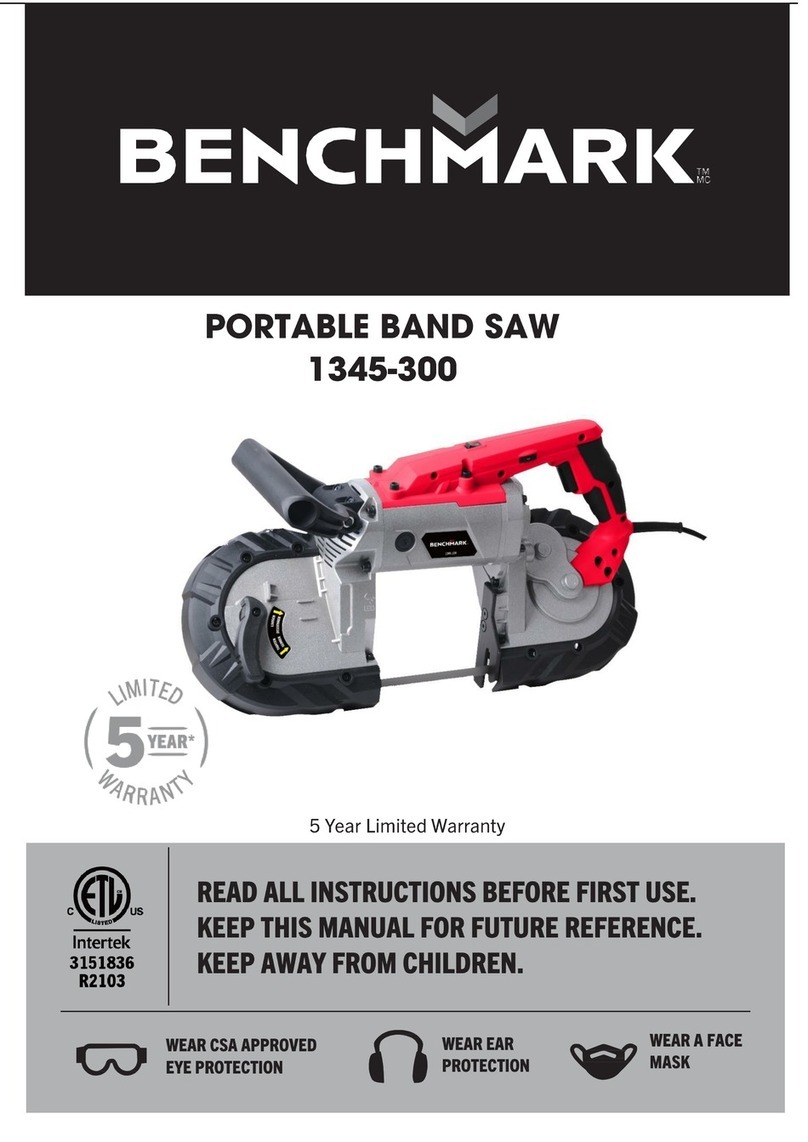
Benchmark
Benchmark 1345-300 User manual
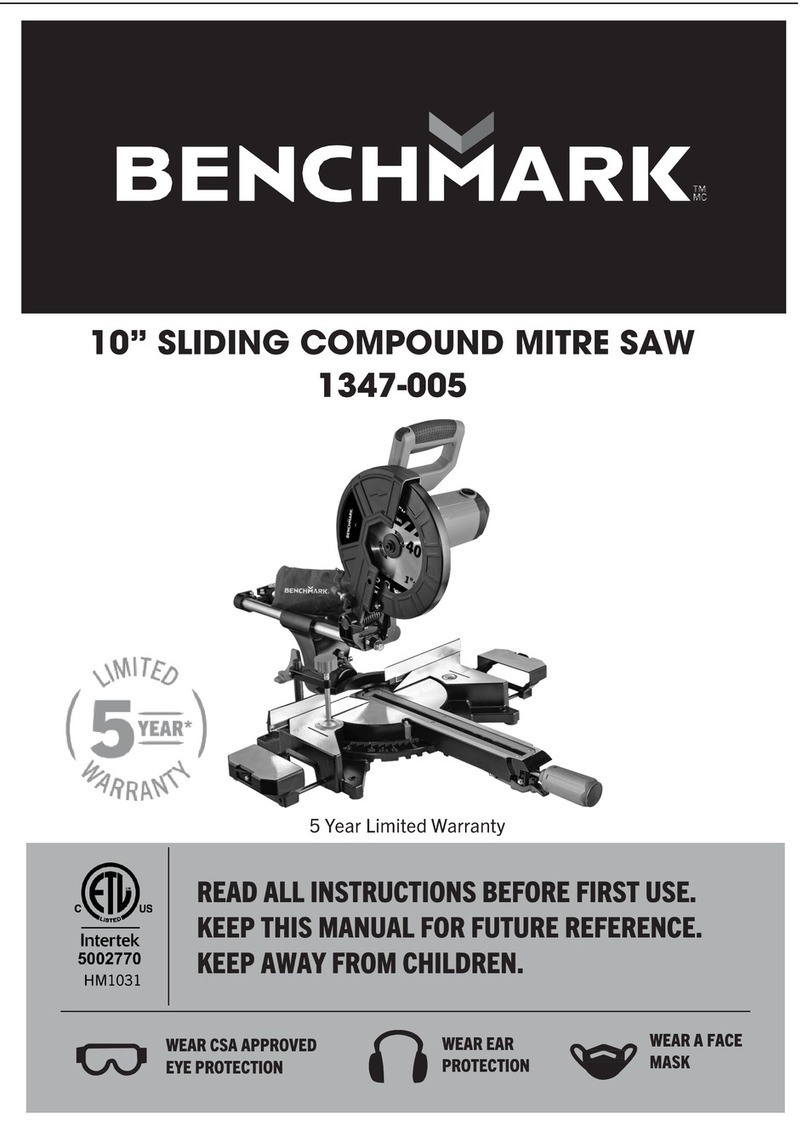
Benchmark
Benchmark 1347-005 User manual
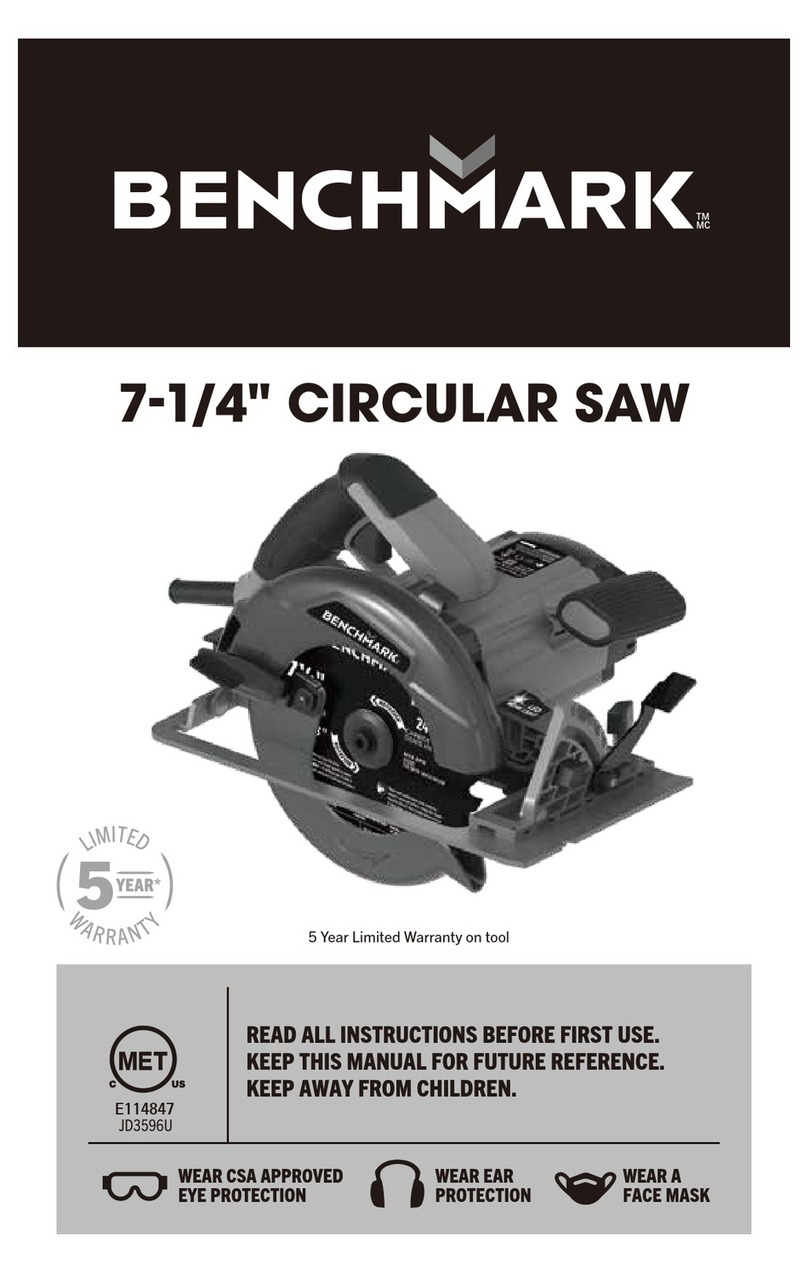
Benchmark
Benchmark 1265-000 User manual

Benchmark
Benchmark 1270-001 User manual
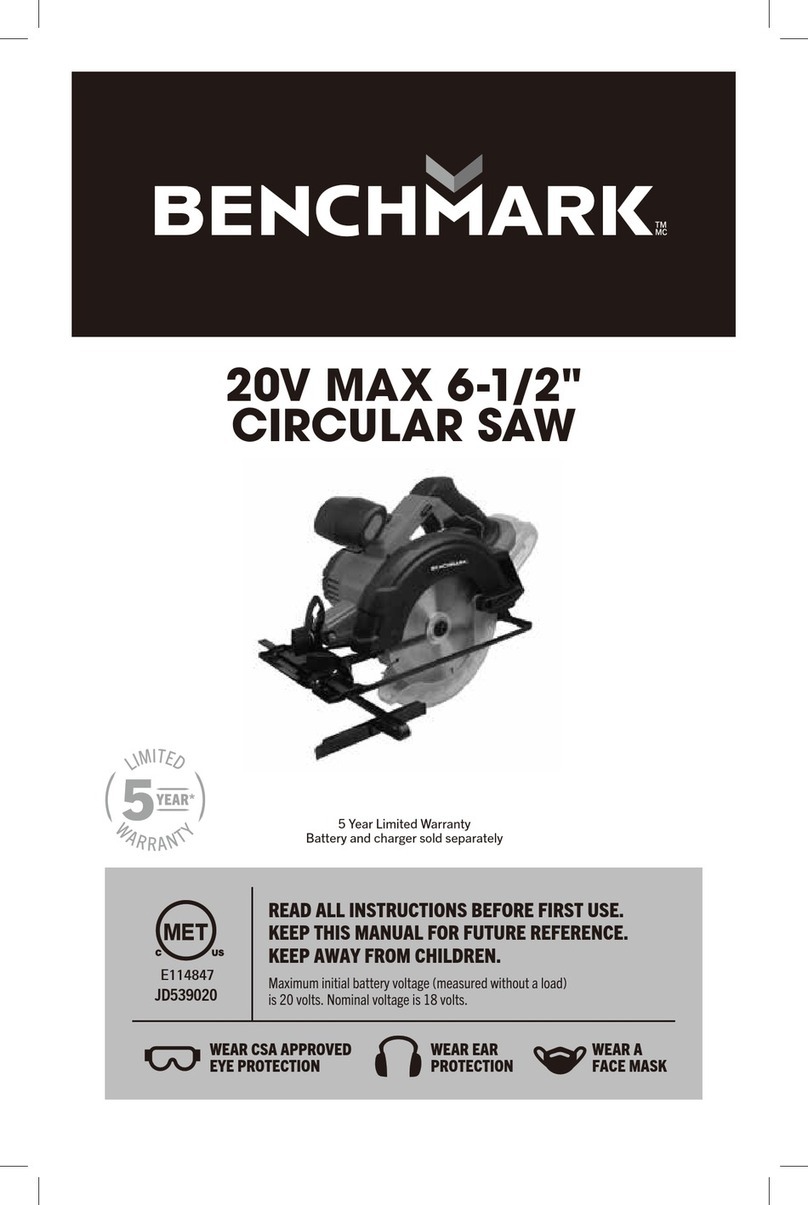
Benchmark
Benchmark 1265-001 User manual
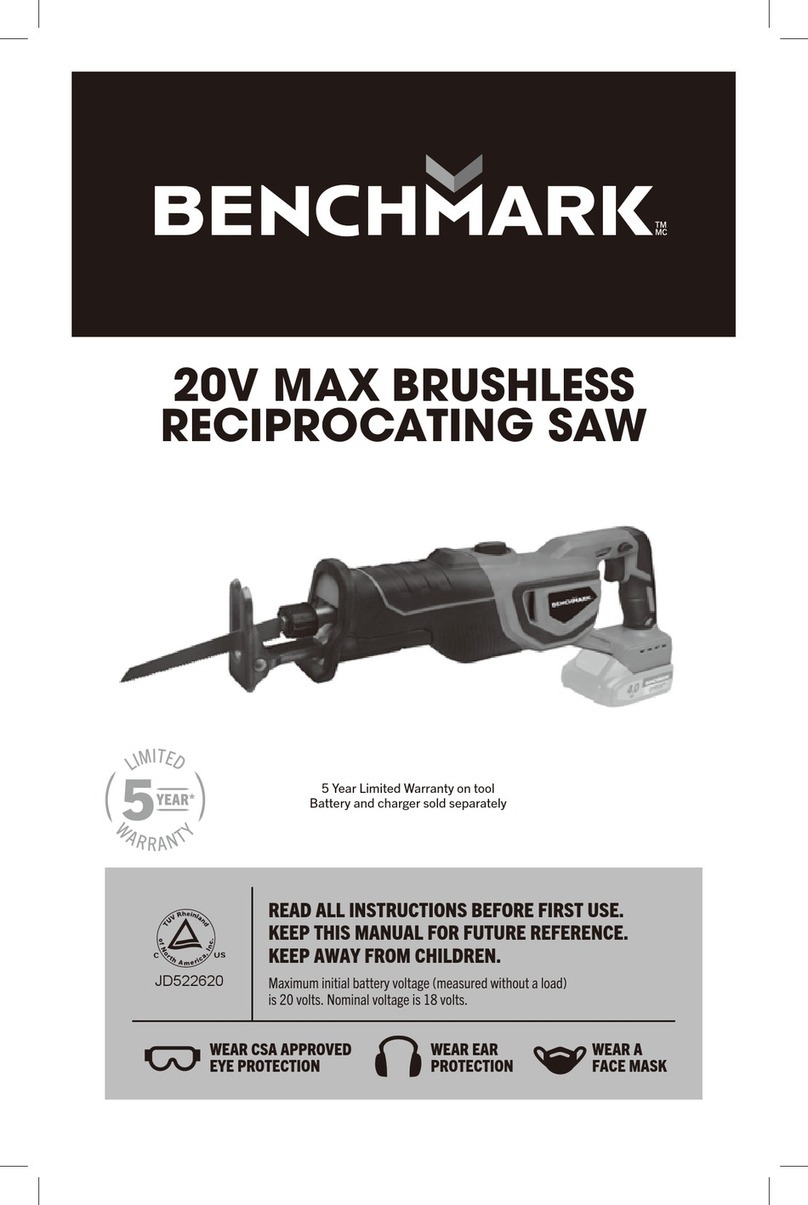
Benchmark
Benchmark 1270-205 User manual
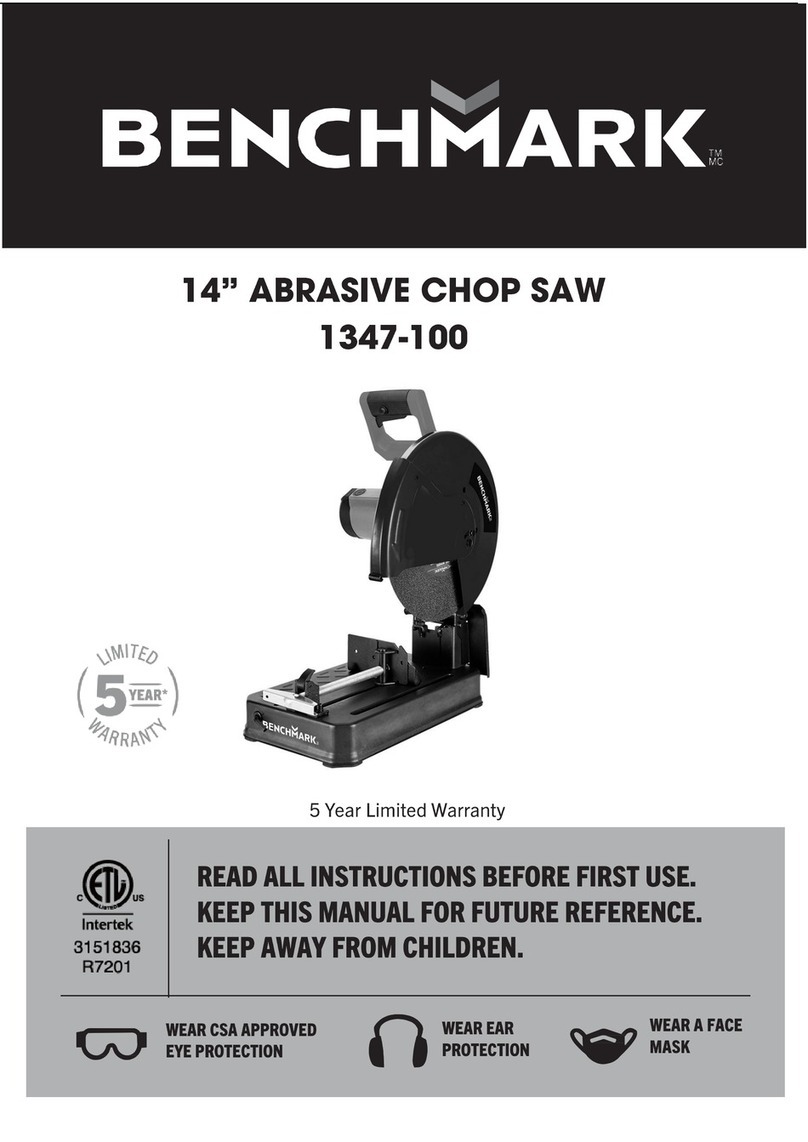
Benchmark
Benchmark 1347-100 User manual
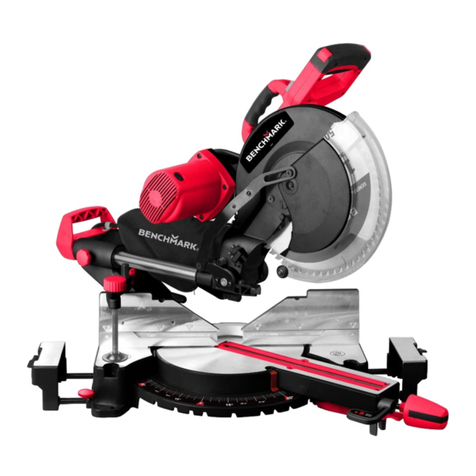
Benchmark
Benchmark 1347-006 User manual
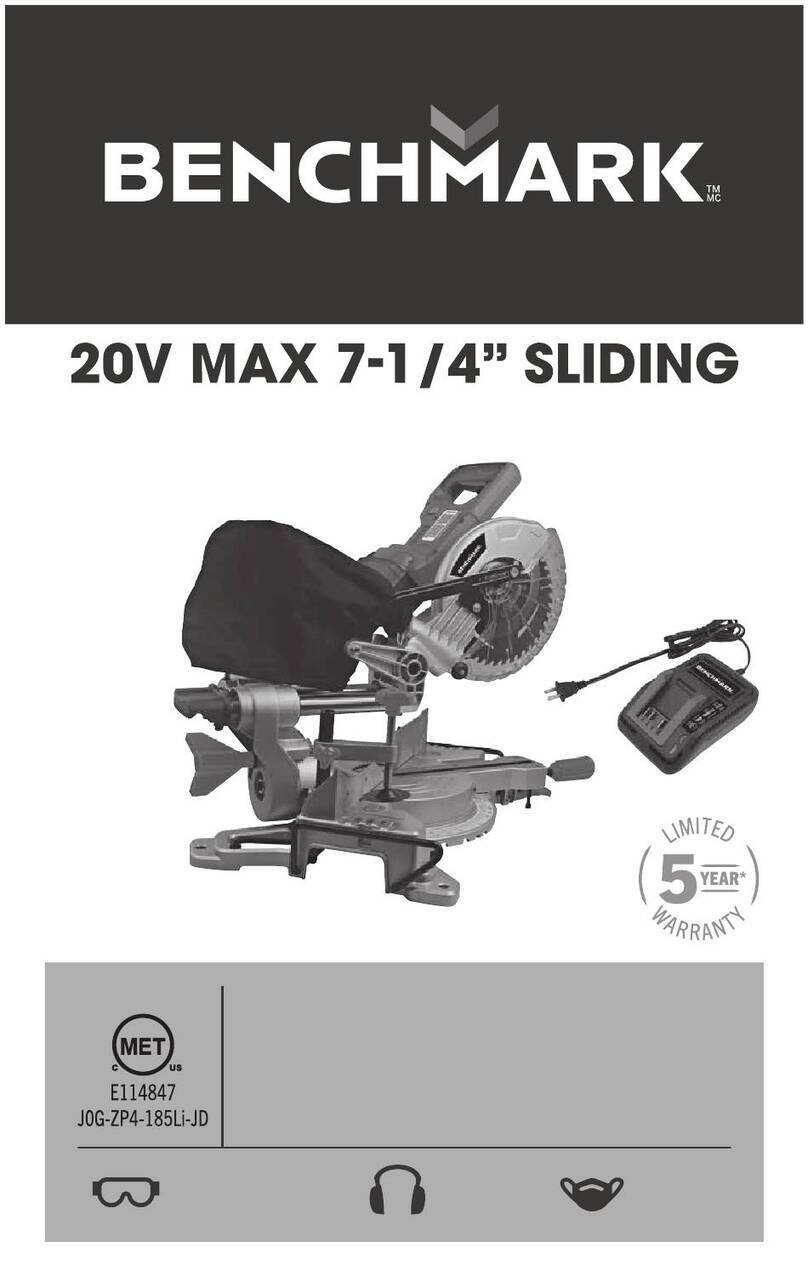
Benchmark
Benchmark 1347-001 User manual
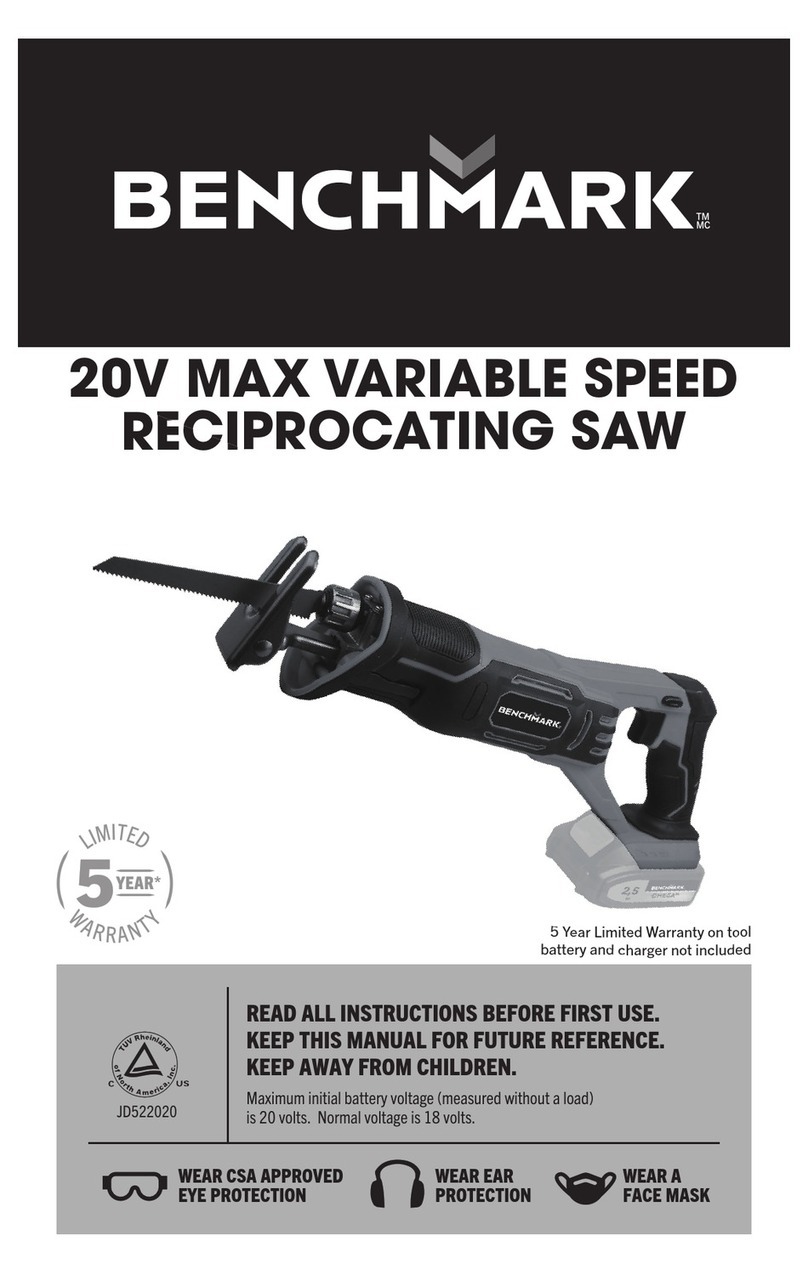
Benchmark
Benchmark 1270-204 User manual
Popular Saw manuals by other brands
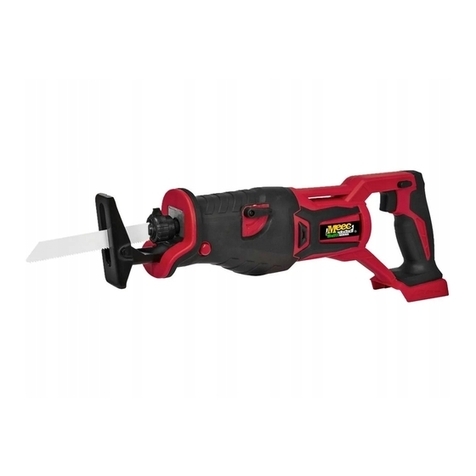
Meec tools
Meec tools Multi Series operating instructions

Woodstock
Woodstock W1673 instruction manual

Nordic
Nordic 61215 operating manual
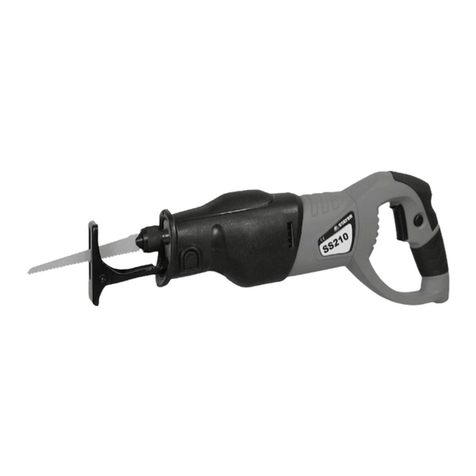
stayer
stayer SS210 operating instructions
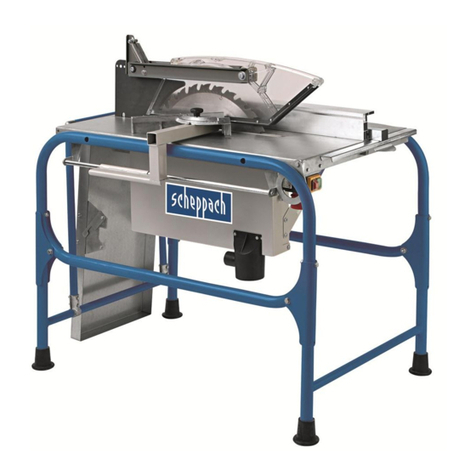
Scheppach
Scheppach Structo 5.0 Series Translation from the original instruction manual
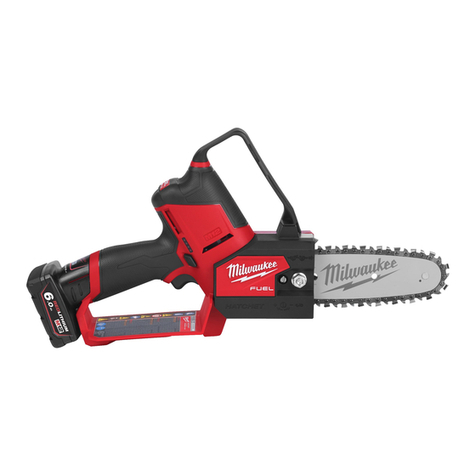
Milwaukee
Milwaukee HATCHET M12 FHS Operator's manual
